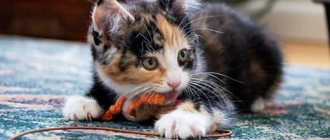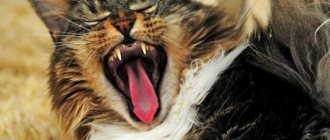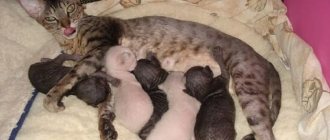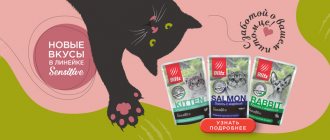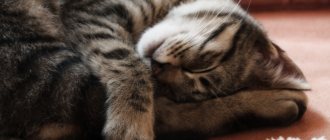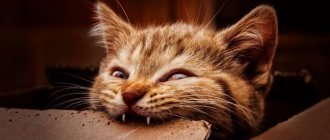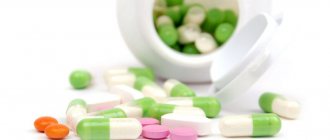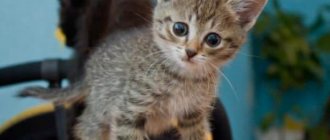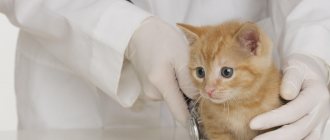Caring for a kitten can be fun, but it is also a huge responsibility. Most people know that they have to take care of things like food, water and shelter, but there are many other aspects to consider.
So before you decide to bring home a kitten, make sure you know what's needed to give them a good chance of a healthy, happy life.
Regular vet visits, vaccinations, parasite prevention, and spaying and neutering are all vital to your pet's overall health.
But did you know that your kitty's dental health is just as important?
More than half of cats over the age of three suffer from dental disease. Cats have some of the same dental problems as dogs, but feline dental care is not sufficiently appreciated.
This article will focus on kitten dental care.
When kittens are teething: symptoms
You may not even notice when your pet's teeth change until you find the ones that have fallen out on the floor or in the basket where he sleeps. This is fine. Most kittens swallow their tiny teeth, but don't worry - it doesn't cause them any harm.
When a kitten's baby teeth change, you may notice the following changes in its behavior:
- Loss of appetite.
- Excessive desire to chew.
- Less frequent washing.
- Soreness and redness of the gums.
- Minor gum bleeding.
- Irritability.
At this stage, the kitten may also begin to scratch its mouth with its paw. If an owner notices this behavior, it may be due to a condition called deciduous teeth, explain experts at Tufts Catnip. However, some baby teeth just don’t want to fall out. This problem is rare, but it is worth paying attention to as the kitten may require tooth extraction.
Tufts emphasizes the importance of looking for signs of gingivitis or periodontal disease, such as severely swollen or bleeding gums and bad breath, when your kitten is teething. If your pet exhibits any of these symptoms, you should immediately contact your veterinarian to ensure your baby receives the necessary treatment.
MILK TEETH IN CATS
Kittens are born without teeth and initially feed only on their mother's milk. First, as expected, kittens’ milk teeth grow, then the kittens’ teeth are replaced by permanent molars.
When kittens change teeth you can read here.
Cats' milk teeth are temporary, not as strong as molars, but nevertheless sufficient to cope well with the task of grinding food.
Cats' milk teeth should be white, clean, and free of plaque.
The kitten is teething: how to help him
Cutting sharp teeth through sensitive gums always causes physical discomfort, but according to Greencross Vets, it's usually minimal.
The kitten will try to reduce the pain and irritation associated with teething. He may even try to use his owner as a chewing toy, which the latter is unlikely to like. In this case, as during other aggressive cat games, you need to switch the kitten’s attention to something else.
One safe item to use as a chew toy is a cool, damp washcloth. You can chew on it as much as you like, and this will help reduce discomfort. Fabric toys and braided ropes are also suitable.
Alternatively, you can purchase kitten chew toys from a pet store, such as those made from nylon that are easy to chew or those that can be kept in the freezer. For the safety of the kitten, it is better for the owner to be nearby while he plays with these toys. In all cases, you should follow the manufacturer's instructions and check toys for integrity, immediately discarding damaged ones.
The kitten may try to chew furniture legs or wires. Such actions can not only lead to damage to things, but also cause harm to the pet. “To prevent accidental injury from destructive chewing, cover electrical cords and wires with protective plastic covers,” advise Your Cat. They also suggest placing double-sided tape on the areas you want to protect from your kitten's sharp teeth.
When your pet needs help
The help of a veterinarian is needed in the following cases:
- inflammation or ulceration of the oral mucosa - gingivitis, stomatitis;
- after a baby tooth falls out on the jaw, a non-healing wound forms in its place, sometimes with signs of purulent inflammation, which indicates periodontitis;
- disruption of the growth of a permanent tooth in the vicinity of an unfallen milk tooth; in this case, both a delay in the growth of a permanent tooth and a change in its position in the dentition are possible, while the tooth may begin to injure soft tissues, the formation of a malocclusion and even deformation of the bones of the facial skull with the formation of asymmetry of the muzzle. The formed double row of teeth contributes to the accumulation of plaque and the development of inflammatory diseases in the oral cavity, a complication of which can be osteomyelitis of the jaw bones with the formation of fistulas. It is recommended to remove a baby tooth in a veterinary clinic under anesthesia.
Unlike irritation, with gingivitis the redness and swelling of the mucous membrane are more pronounced; pus, pain, anxiety, depression, refusal to feed may appear
The importance of good oral hygiene in kittens
Dental and gum disease is common in cats, but making an effort to maintain your kitten's oral health can help prevent future occurrences.
Regular dental care with exams and cleanings can reduce medical costs and prevent diseases such as gingivitis, periodontitis and tooth resorption. It is worth starting the procedure after teething has finished to avoid additional discomfort for the kitten. It is necessary to give the kitten food appropriate for its age - this will also alleviate the painful condition associated with teething.
The kitten may not tolerate this process well, so be sure to give him a lot of love, support and patience until all the new teeth are in place.
Advice from a veterinarian-dentist
Removal of any fixed teeth, no matter whether they are temporary or permanent, must be carried out using anesthesia and analgesia. Dental pain is a moderate pain and proper analgesia is required for every patient.
To the question, is it possible to anoint the gums with something anesthetic or give them local anesthesia like in humans, I will answer right away - no, it is not possible.
Local analgesic gels will anesthetize the mucous membrane of the gums and tongue and increase salivation in the dog, which can lead to vomiting and aspiration of vomit into the trachea, and in cats their use is even more dangerous, since such gels can lead to laryngospasm and respiratory arrest. Unfortunately, a local injection into the gum cannot be carried out without the use of sedatives that induce sleep. I have a hard time imagining a cat or dog whose gum someone tries to stick a needle into. But even if this happened, after such an injection no patient will ever be allowed near him again.
Gil Veronika Yurievna, veterinarian, surgeon, dentist
https://gilvet.ru/stati/molochnye-zuby-u-sobak-i-koshek/
Captive temporary teeth, which are already being replaced by permanent teeth, are called persistent and must be removed at the first visible changes in the bite.
It is impossible to leave persistent teeth, because the dentition of an adult dog is designed for 42 teeth, and for a cat 30, and if there are more teeth, periodontitis will begin... The age for removing baby teeth is not a specific number. Everything happens individually for each animal, and to say, for example, that the optimal age is 8 months is wrong. Each animal has a different age for extraction; some require removal of persistent teeth as early as 5 months of age.
Gil Veronika Yurievna, veterinarian, surgeon
https://gilvet.ru/stati/molochnye-zuby-u-sobak-i-koshek/
In some puppies and kittens, the change of teeth occurs with an increase in body temperature and a decrease in appetite, sometimes even with a refusal to feed. In such situations, it is better to consult a doctor for help.
In cats, during the change of teeth, a very strong odor from the oral cavity is not a strong pathology, and if you see double rows of teeth (both permanent and temporary), know that this occurs normally. But if you notice that your permanent teeth are starting to grow and interfere with each other, you need to consult a specialist.
Gil Veronika Yurievna, veterinarian, surgeon, dentist
https://gilvet.ru/stati/molochnye-zuby-u-sobak-i-koshek/
If they removed temporary teeth and broke the crown, leaving the root in the gum with the words “it will resolve on its own,” I answer - no, it will not resolve.
Why should the root of a tooth dissolve because you have broken the crown? It will remain in the gums as a foreign body and at a certain time can cause the process of periodontitis of adjacent teeth or osteomyelitis of the jaw bones...
With any injury to the crown of a temporary canine, traumatic pulpitis occurs, and as a result, periodontitis develops with an abscess on the jaw, inside of which there is a rudiment of a permanent canine. Trauma, pain, inflammation and the possible loss of not only a temporary, but also a permanent canine - this is the price to pay for an incompetent attempt at self-medication.
In case of traumatic pulpitis of a temporary canine, the tooth must be immediately extracted (removed).
Gil Veronika Yurievna, veterinarian, surgeon, dentist
https://gilvet.ru/stati/molochnye-zuby-u-sobak-i-koshek/
If the temporary tooth is mobile and “almost transparent to the light”, there is no need to remove it at all - let the animal chew on something in which to sink the teeth (for example, a not very hard “chew” or a large treat), and, believe me, the tooth will fall out on its own .
Gil Veronika Yurievna, veterinarian, surgeon, dentist
gilvet.ru/stati/molochnye-zuby-u-sobak-i-koshek/
Video: cat dental care
Diarrhea in a baby - parental behavior tactics
12.04.2021
Diarrhea in a baby can drive parents crazy - bowel movements are disrupted, the child is worried, sleeps poorly or a lot, does not eat, cries. This may increase the temperature. When the first symptoms appear, it is necessary to understand the cause, take the first measures and follow the basic recommendations.
Causes of diarrhea
Diarrhea in infants refers to a change in stool consistency. It becomes watery, with mucus and undigested food particles, the number of bowel .
Causes of this condition:
- viral or bacterial intestinal infections;
- improper nutrition of the baby or mother if she is breastfeeding ;
- food intolerance to lactose, gluten and other elements;
- surgical pathologies;
- changing the formula or abrupt transition to artificial feeding with breastfeeding;
- taking certain medications, such as antibiotics.
Normally, diarrhea is not observed teething . If the condition occurs, most likely due to a weakened immune system , a bacterial or viral intestinal infection has occurred. The reason for this is that to facilitate teething , babies often put toys and objects in their mouths that may not be processed or washed.
Doctors call dysbacteriosis a common cause of diarrhea . Many experts refute this diagnosis.
What should mom do?
diarrhea occurs in a child of the first year of life, you should consult a doctor . Assigned groups for this symptom:
- sorbents;
- antibacterial drugs;
- medications to normalize intestinal ;
- antipyretics for high temperatures;
- antiviral agents.
Sorbents bind allergens , toxins, bacteria and their waste products, and other factors that provoke diarrhea and remove them from the child’s body. As a result, nausea , vomiting, and diarrhea .
If the cause is determined to be a bacterial intestinal infection and the causative agent is identified, antibacterial drugs may be recommended by the pediatrician . It is unacceptable to take them on your own.
For a quick recovery and elimination of imbalances in the intestinal , probiotics and prebiotics are indicated. These drugs are taken in a course and after the symptoms disappear for 10 days. When purchasing medications, you must pay attention to the storage conditions.
If diarrhea , antiviral drugs in the form of suppositories can be used.
Recommendations
A dangerous consequence of diarrhea in infants is dehydration. To prevent it, you need to give your baby water more often. If this is not possible with a cup or bottle, you can use a teaspoon or a syringe without a needle. If you have severe symptoms of dehydration, call an ambulance.
If your baby is breastfed, put him to your breast . This helps satiate the baby, replenish lost fluids and calm the baby. This is especially important in cases where it is not possible to drink with clean water.
Another recommendation concerns the child's nutrition. vegetables, dairy products, fruits and juices should be removed during diarrhea
For several days, you need to observe the baby's skin - dryness, the appearance of a rash, pallor and feces - the presence of streaks of blood , foam, mucus, color changes.
When do you need to see a doctor?
a doctor diarrhea occurs in a child under one year of age . Immediate attention is required in cases where there are streaks of blood and mucus in the stool, the baby has a high fever and is vomiting.
Self-medication of such a symptom in children of the first life is contraindicated. There is a high risk of dehydration and complications.
Signs of dehydration:
- dry skin, mucous membranes, tongue;
- retraction of the fontanel;
- dry mouth , crying without tears;
- weight loss due to decreased fluid in stool and vomit;
- decreased urination , urine becomes darker;
- capriciousness, lethargy of the child.
diarrhea in an infant requires qualified medical care - the pediatrician, together with the mother, will determine the possible cause, prescribe treatment and select the dosage of medications. During therapy, it is extremely important to give more liquid or put the baby to the breast , monitor the amount of urine , feces, and skin excreted.
Published in Gastroentorology Premium Clinic
Possible complications when changing teeth
The replacement of baby teeth with permanent ones is a common natural phenomenon in kittens. It is mostly asymptomatic. Unless your gums may turn slightly red. However, monitoring of the kitten's condition will be required.
Contacting a veterinary clinic is necessary if you notice non-healing festering wounds in the mouth, a bad mood in the cat, loss of appetite, suppuration on the gums, or the appearance of wounds near the grown permanent incisors or fangs.
A doctor’s help is also needed if new teeth erupt before baby teeth fall out.
Oral diseases in cats
A big problem when teething with incisors in cats is severe inflammation of the gums.
Gum inflammation
Prolonged inflammation of the gums in cats when changing teeth is characterized by the following signs:
- restless cat behavior;
- refusal to eat due to pain in the mouth;
- ptyalism;
- swelling and noticeable redness of the gums.
Kitten care
When replacing milk teeth with permanent ones, caring owners should create special conditions for keeping the cat, its nutrition, oral hygiene and general purring behavior.
Kitten oral hygiene
A cat should be accustomed to cleaning from the first months of life, so as not to be tormented later with an adult cat. Veterinarians advise starting with a game - let the little purr get used to his toothbrush. This way he won't be afraid of her.
Later, the kitten will even appreciate the opportunity to scratch his itchy gums on the bristly surface of the brush.
Hygiene procedures for the kitten's oral cavity should be performed 1-2 times a month. This procedure is an excellent prevention of periodontitis and tartar.
Nutritional Features
A small pet should be fed taking into account its age characteristics, regardless of the replacement of fangs. Caring owners should know that the health of a kitten’s oral cavity is promoted by food rich in phosphorus, calcium, as well as vitamins A and D. The cat will benefit from: boiled lean meat and fish, rice and oatmeal, milk, kefir, cottage cheese, pumpkin and zucchini.
When feeding industrial food, preference should be given to products made directly for kittens. Such food contains a balanced vitamin and mineral complex, specially designed for the growth of a young cat's body.
By eating such food, the kitten receives the proper amount of microelements necessary for oral health.
How to behave with a pet
Itching in the gum area during the eruption of incisors and fangs always causes stress in kittens. During this period, owners are encouraged to correct the cat's behavior. You should not allow your cat to chew on anything - this can harm the baby’s health.
During these several months, it is better not to vaccinate the purr, so that the vaccination does not harm its health.
CENTERY OF ELITE BRITISH CATS, KITTENS ELITE BRITISH
Cats' teeth are one of the indicators of health and good nutrition. Cats' teeth should be strong, white, and have the correct bite.
DO CATS' TEETH CHANGE? DO CATS' TEETH CHANGE?
Many kitten owners, having acquired a small pet, ask the question “do kittens’ teeth change?” Kittens' teeth, of course, change. Read more about tooth loss in kittens here.
CHANGE OF TEETH IN KITTENS
So, the kitten’s teeth are changing, the symptoms are: excessive salivation, the desire to gnaw everything that the kitten comes across, also, when cats change teeth, a short-term loss of appetite is possible. Also, the change of teeth in kittens is expressed by symptoms of swelling of the gums, not very pronounced redness. The replacement of baby teeth in kittens takes on average 3 months. See the table for the change of baby teeth in cats by age.
| Kitten dental system | Kitten age |
| The appearance of teeth in kittens | 2-12 weeks |
| Changing baby teeth in kittens | 3-5 months |
| Formation of the molar dental system in kittens | 5-8 months |
Kittens begin to change teeth at the age of 3 months. A kitten's teeth fall out at the age of 3-5 months. So a 5-month-old kitten’s teeth should already be fully formed; the change of teeth in cats less often ends at the age of 7-8 months.
Changing teeth in kittens
Cats change their teeth gradually, starting with the front incisors. Changing teeth in kittens in the photo.
Kittens' teeth change, just like children's. The process is quite lengthy, but painless for pets.
An adult cat has only 30 teeth, so when the molars come in, you can notice signs of gum irritation. At this time, it is necessary to periodically examine the teeth to ensure that the gums do not become inflamed. Also, when a cat’s teeth change, the animal may lose its appetite.
Tooth loss in cats usually goes unnoticed and you can even skip this period.
HOW TO HELP A KITTEN WITH A CHANGE OF TEETH?
When replacing baby teeth with molars, offer the kitten dry food. This way, you will ease the period when the animal’s gums itch. Also, dry food for kittens contains the necessary amount of minerals that a kitten needs during the period of active growth. Nutrition should be balanced. Additionally, you can let your pet play with toys that can be chewed and your wires will remain intact.
Please note that additional vitamins can be given only after prior consultation with a veterinarian, and only with his approval. After all, if the kitten is healthy and eats a balanced diet, there is no need for additional vitamins.
When changing teeth, you can use special veterinary dry food for the oral cavity.
SYMPTOMS OF TEETH CHANGE IN KITTENS
In most cases, people skip the teething period of kittens. However, there are symptoms that cannot be ignored. The baby may refuse to eat if the gums are very sore. Bad breath can also occur when changing teeth. Carefully examine the animal's oral cavity and if severe redness or ulcers appear on the mucous membrane, consult a doctor immediately.
A situation quite often occurs: the molar has already erupted, but the baby tooth stands in place like a fortress. There is such a term - the hole is the place from which the tooth grows. So, molars do not grow from the same socket as baby teeth. In this situation, just observe, if the baby tooth does not fall out for a long time, and the gums are inflamed, then, therefore, the tooth is bothering the kitten, contact the veterinary clinic for advice, it may require removal.
WHY SHOULD YOU PAY SPECIAL ATTENTION TO CHANGING TEETH?
When teeth change, a kitten develops a bite. If a baby tooth does not fall out on time, this can provoke further incorrect formation of the jaw position and bite.
There are also concepts such as jaw misalignment, underbite or overbite - in the process of changing teeth you can significantly influence the situation and reveal positive dynamics. It is recommended to brush your teeth and take regular daily proper care of your cat during the period of intensive growth and development.
WHAT TEETH DO KITTENS CHANGE?
Kittens lose their milk teeth: incisors, canines, molars, premolars; then all the molars grow accordingly.
| In our cattery you can “buy a real British kitten.” We have many different colors, we will help you choose and answer all your questions! |
At what age should a kitten grow all its permanent teeth?
Between 3 and 4 months of age, the kitten begins to lose its first baby teeth, usually its incisors. The change occurs under the pressure of the molars, which begin to cut out of the gums and push out the milk teeth. Upon careful examination, you may find the tip of a molar even before the baby tooth falls out.
On the Internet you can find a lot of data about the “order” of changing teeth, but they have no scientific basis. The order of teeth replacement was determined experimentally and by observations of kittens. Thus, the front incisors are most likely to fall out first. Afterwards, the fangs or teeth that stand immediately behind them fall out.
Note! All permanent teeth erupt between the ages of 6 and 8 months, depending on the individual characteristics of the pet’s body.
At what age do fangs change?
Many owners see a reason for concern in the late change of canines. In fact, a canine is a very complex and long tooth that takes a long time to grow. If the primary canine has fallen out and the molar has erupted, there is no reason to worry.
Molars grow very slowly because they must fill all the gaps in the dentition as the jaws grow. Fangs can take longer to develop and form for a number of pathological reasons, but until the age of six months, it is enough to monitor the pet’s condition; no measures need to be taken.
Note! If the baby fangs have fallen out, but the molars have not come in, it is important to make sure that the kitten receives a balanced diet and has enough microelements.
